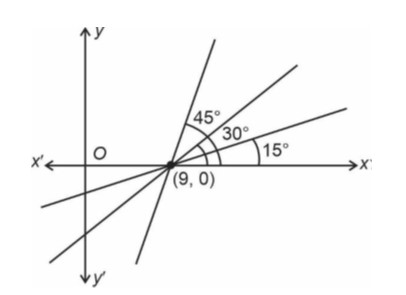Let m1, m2 be the slopes of two adjacent sides of a square of side a such that a2 + 11a + If one vertex of the square is where and the equation of one diagonal is then is equal to
Let m1, m2 be the slopes of two adjacent sides of a square of side a such that a2 + 11a + If one vertex of the square is where and the equation of one diagonal is then is equal to
Option 1 -
119
Option 2 -
128
Option 3 -
145
Option 4 -
155
-
1 Answer
-
Correct Option - 2
Detailed Solution:for square a,b,c,d let
Diagonal : (cosα - sinα)x + (sinα + cosα)y = 10
BD (diagonal)
Dist. Of BD from A is
Also, a2 + 11a + 3
210 + 3
Also, m1 m2 = -1
m2 +
or
m =
m =
Diagonal AC:
=10 cos2α - 10cos2α = 0
Slope of AC =
FIGURE
? =
Similar Questions for you
Eqn : y – 0 = tan45° (x – 9) Þ y = (x – 9)
Option (B) is correct
|r1 – r2| < c1c2 < r1 + r2
->
Now,
(y – 2) = m (x – 8)
⇒ x-intercept
⇒
⇒ y-intercept
⇒ (–8m + 2)
⇒ OA + OB =
->
->
->
->Minimum = 18
Kindly consider the following figure
According to question,
Equation of required line is
Obviously B (2, 2) satisfying condition (i)
Taking an Exam? Selecting a College?
Get authentic answers from experts, students and alumni that you won't find anywhere else
Sign Up on ShikshaOn Shiksha, get access to
- 65k Colleges
- 1.2k Exams
- 679k Reviews
- 1800k Answers

